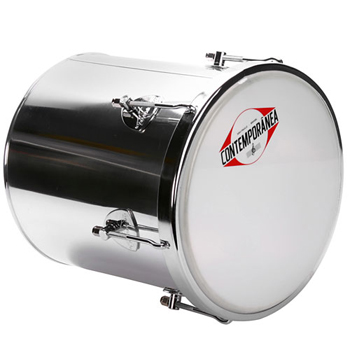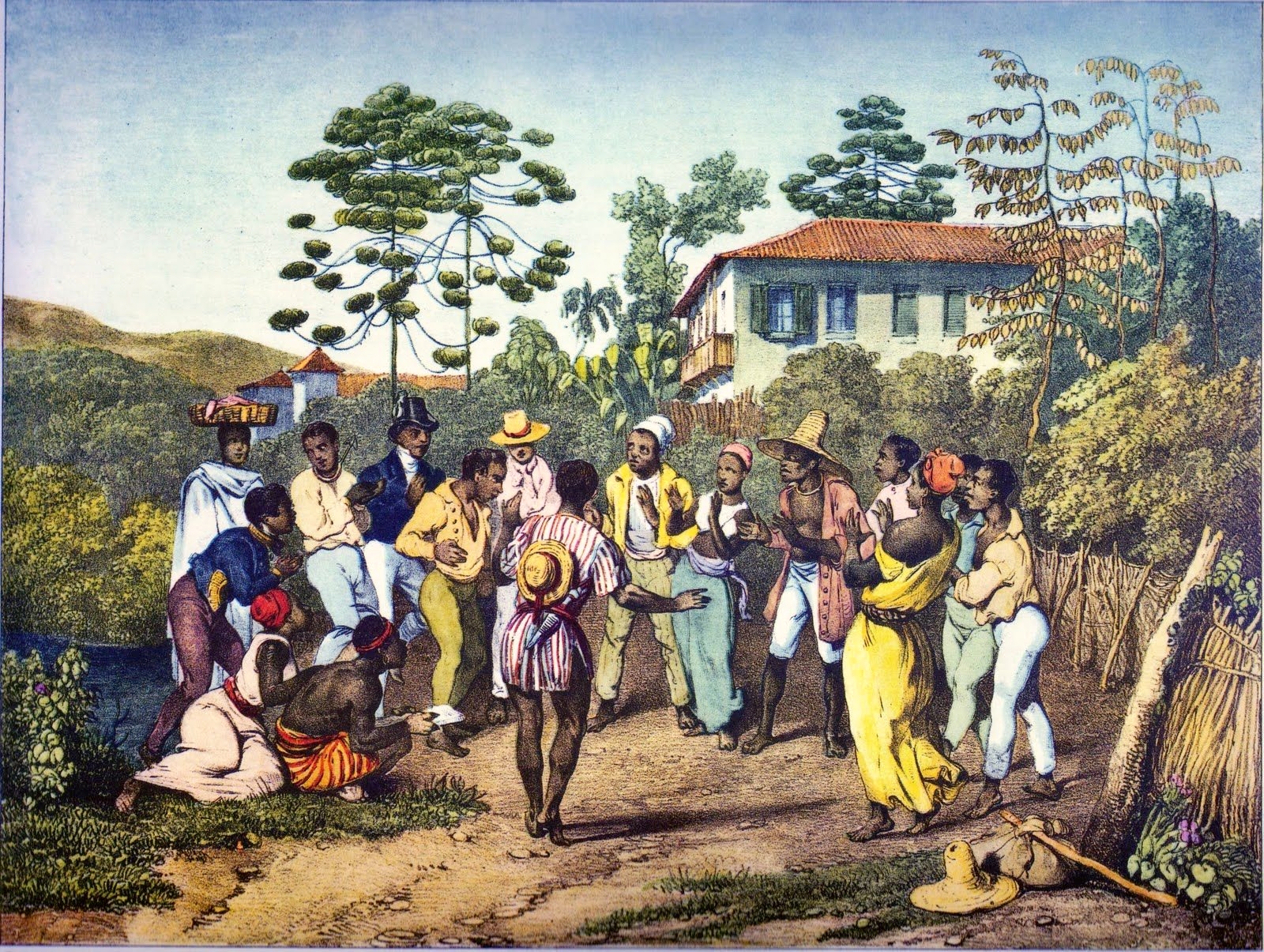|
Hand-repique
The hand-repique is a percussion instrument originated in Brazil. It’s a small drum of cylindrical form, that can be made of wood, aluminum or acrylic. It’s played with the hands, both on the skin and its body. The hand-repique has a sharp sound and is used mainly to play Samba and its variants, such as Pagode. Its common role inside these genres is to increase the percussion section, filling up the spaces and playing the off-beats. It was invented by musician Ubirany, founder and percussionist with the band "Fundo de Quintal". The hand-repique is derived from another percussion instrument, the "Repinique". Ubirany started to use the repinique in its band but felt it was too uncomfortable to play, since this instrument is made to be originally played with a drumstick. So he adapted it, adding a few mufflers on the inside, lowering the hoop and taking the bottom skin off it. It became so popular that it began to be produced by several manufactures (such as Gope, Contemporânea a ... [...More Info...] [...Related Items...] OR: [Wikipedia] [Google] [Baidu] |
Fundo De Quintal
Grupo Fundo de Quintal or simply Fundo de Quintal (''Backyard Group'', roughly) is a Brazilian Samba band formed in Rio de Janeiro at the end of the 1970s. History The founding members of Fundo de Quintal, Almir Guineto (banjo/ cavaco), Bira Presidente (pandeiro), Jorge Aragão (acoustic guitar), Neoci (tan-tan), Sereno (tan-tan), Sombrinha (acoustic guitar/chip) and Ubirany (hand-repique), used to perform on Wednesdays in the sambas at the headquarters of the carnival block Cacique de Ramos in the mid-1970s. With the introduction of such instruments as the tan-tan, hand-repique and banjo, the group created a completely innovative style in samba (which, later on, the Brazilian music industry called pagode). Patronized by the famous samba singer Beth Carvalho, Fundo de Quintal recorded its first album, ''Samba É No Fundo de Quintal'', in 1980. Shortly thereafter, Almir Guineto and Jorge Aragão left the group to pursue a solo career, in addition to Neoci, who soon died. Arlindo ... [...More Info...] [...Related Items...] OR: [Wikipedia] [Google] [Baidu] |
Samba
Samba () is a broad term for many of the rhythms that compose the better known Brazilian music genres that originated in the Afro-Brazilians, Afro Brazilian communities of Bahia in the late 19th century and early 20th century, It is a name or prefix used for several rhythmic variants, such as samba urbano carioca (''urban Carioca samba''), samba de roda (sometimes also called ''rural samba''), among many other forms of samba, mostly originated in the Rio de Janeiro (state), Rio de Janeiro and Bahia states. Having its roots in Brazilian mythology, Brazilian folk traditions, especially those linked to the primitive rural samba of the Colonial Brazil, colonial and Empire of Brazil, imperial periods, is considered one of the most important cultural phenomena in Brazil and one of the country symbols. Present in the Portuguese language at least since the 19th century, the word "samba" was originally used to designate a "popular dance". Over time, its meaning has been extended to a "B ... [...More Info...] [...Related Items...] OR: [Wikipedia] [Google] [Baidu] |
Pagode
Pagode () is a Brazilian style of music that originated in Rio de Janeiro, Brazil, as a subgenre of Samba. Pagode originally meant a celebration with food, music, dance, and party. In 1978, singer Beth Carvalho was introduced to this music, liked it from the beginning, and recorded tracks by Zeca Pagodinho and others. Over time, pagode has been used by many commercial groups, which have included a version of the music filled with clichés, and there is now a sentiment that the term is a pejorative for "very commercial pop music" (see Samba#Pagode Romântico, Pagode Romântico). Original pagode developed at the beginning of the 1980s, with the advent of the band Fundo de Quintal and the introduction of new instrumen ... [...More Info...] [...Related Items...] OR: [Wikipedia] [Google] [Baidu] |
Ring-repique
The ring-repique is a percussion instrument originated in Brazil. It is a small drum commonly made of aluminum, and unlike the hand-repique, has two drumheads (top and bottom, commonly made out of animal skin), and a different, much deeper timbre. In Brazil, this instrument is used mainly to play Samba and its variants, such as Pagode. The ring-repique has this name because traditionally, the musician wears one or more rings to play it, striking the body of the instrument with his fingers and using his thumb to play on the bottom or top skins. Normally the free hand hits the top skin, and this technique allows the player to perform more than one rhythm. The ring-repique was invented in the 1970s by musician Doutor. See also * Repinique *Hand-repique The hand-repique is a percussion instrument originated in Brazil. It’s a small drum of cylindrical form, that can be made of wood, aluminum or acrylic. It’s played with the hands, both on the skin and its body. The hand-repique ... [...More Info...] [...Related Items...] OR: [Wikipedia] [Google] [Baidu] |
Repinique
A repinique is a two-headed drum used in samba '' baterias'' (percussion ensembles). It is used in the Rio de Janeiro and São Paulo Carnival baterias and in the baterias of Bahia, where it is known as ''repique''. It is equivalent to the tik-tik in the non-Brazilian drum kit or to the tenor drum in marching bands. It is tuned very high to produce a tone that cuts through the sound of the rest of the bateria and is used as both a lead and solo instrument. Typically its body is made of metal. The heads, made of nylon, are tightened through the use of metal tuning rods. The instrument is usually smaller in diameter than the Brazilian caixa (snare drum) but several inches longer in height and lacking a snare. It is carried using a shoulder strap attached to one of the tuning rods. In Rio-style samba it is played with one wooden stick and one hand. In Bahia it is played with two wooden sticks usually but in some cases also like the Rio-style (the ''bloco afro'' Ilê Aiyê for ex ... [...More Info...] [...Related Items...] OR: [Wikipedia] [Google] [Baidu] |
Brazilian Percussion
Brazilian commonly refers to: * Brazil, a country * Brazilians, its people * Brazilian Portuguese, its dialect Brazilian may also refer to: * "The Brazilian", a 1986 instrumental music piece by Genesis * Brazilian Café, Baghdad, Iraq (1937) * Brazilian cuisine ** Churrasco, or Brazilian barbecue * Brazilian-cut bikini, a swimsuit revealing the buttocks * Brazilian waxing, a style of pubic hair removal * Mamelodi Sundowns F.C., a South African football club nicknamed ''The Brazilians'' See also * Brazil (other) * ''Brasileiro ''Brasileiro'' is a 1992 album by Sérgio Mendes and other artists including Carlinhos Brown which won the 1993 Grammy Award for Best World Music Album. It marked Mendes's return to Elektra Records since 1979's ''Magic Lady'' with Brasil '8 ...'', a 1992 album by Sergio Mendes * Brazilian jiu-jitsu, a martial art and combat sport system * Culture of Brazil * Football in Brazil {{Disambiguation Language and nationality disambiguation p ... [...More Info...] [...Related Items...] OR: [Wikipedia] [Google] [Baidu] |

